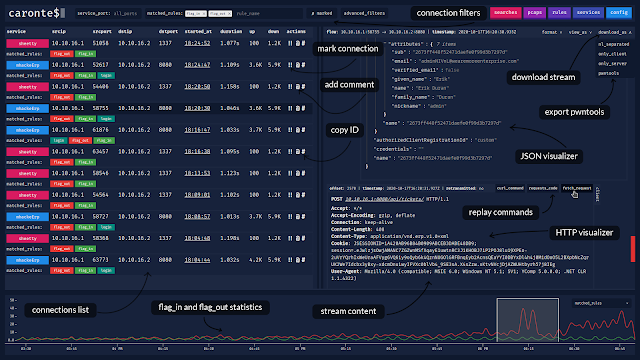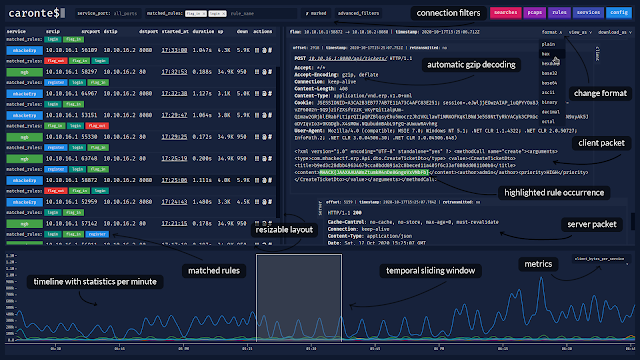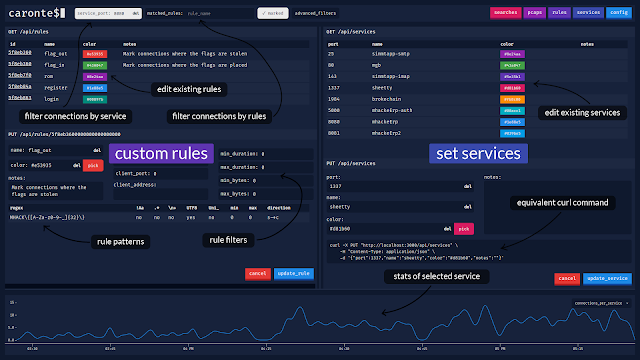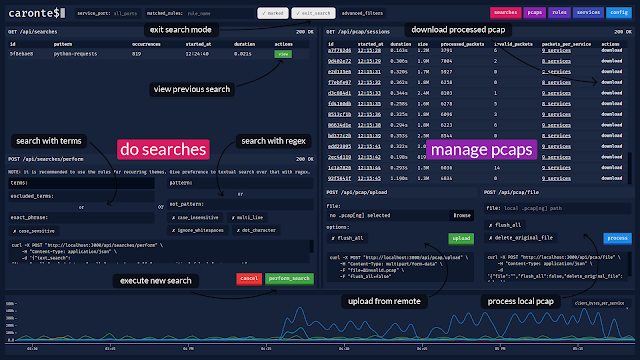Caronte is a tool to analyze the network flow during capture the flag events of type attack/defence. It reassembles TCP packets captured in pcap files to rebuild TCP connections, and analyzes each connection to find user-defined patterns. The patterns can be defined as regex or using protocol specific rules. The connection flows are saved into a database and can be visualized with the web application. REST API are also provided.
Features
immediate installation with docker-compose no configuration file, settings can be changed via GUI or API pcaps to be analyzed can be loaded via curl, either locally or remotely, or via the GUI it is also possible to download the pcaps from the GUI and see all the analysis statistics for each pcap rules can be created to identify connections that contain certain strings pattern matching is done through regular expressions (regex) regex in UTF-8 and Unicode format are also supported connections can be labeled by type of service, identified by the port number each service can be assigned a different color ability to filter connections by addresses, ports, dimensions, time, duration, matched rules a timeline shows statistics with different metrics sampled per minute some of these metrics are connections_per_service, client_bytes_per_service, server_bytes_per_service, duration_per service, matched_rules with matched_rules metric it can be possible to see the relationship between flag_in and flag_out the timeline contains a sliding window which can be used to search for connections in a certain time interval advanced search by term, negated term, exact phrase, regex, negated regex the performed searches are saved to be instantly repeated the following times the detected HTTP connections are automatically reconstructed HTTP requests can be replicated through curl, fetch and python requests compressed HTTP responses (gzip/deflate) are automatically decompressed ability to export and view the content of connections in various formats, including hex and base64 JSON content is displayed in a JSON tree viewer, HTML code can be rendered in a separate window occurrences of matched rules are highlighted in the connection content view supports both IPv4 and IPv6 addresses if more addresses are assigned to the vulnerable machine to be defended, a CIDR address can be usedInstallation
There are two ways to install Caronte:
with Docker and docker-compose, the fastest and easiest way manually installing dependencies and compiling the projectRun with Docker
The only things to do are:
clone the repo, with git clone https://github.com/eciavatta/caronte.git inside the caronte folder, run docker-compose up -d wait for the image to be compiled and open browser at http://localhost:3333Manually installation
The first thing to do is to install the dependencies:
go >= 1.14 https://golang.org/doc/install node >= v12 https://nodejs.org/it/download/ yarnpkg https://classic.yarnpkg.com/en/docs/install/ hyperscan >= v5 https://www.hyperscan.io/downloads/Next you need to compile the project, which is composed of two parts:
the backend, which can be compiled with go mod download && go build the frontend, which can be compiled with cd frontend && yarn install && yarn buildBefore running Caronte starts an instance of MongoDB https://docs.mongodb.com/manual/administration/install-community/ that has no authentication. Be careful not to expose the MongoDB port on the public interface.
Run the binary with ./caronte. The available configuration options are:
Configuration
The configuration takes place at runtime on the first start via the graphical interface or via API. It is necessary to setup:
the server_address: the ip address of the vulnerable machine. Must be the destination address of all the connections in the pcaps. If each vulnerable service has an own ip, this param accept also a CIDR address. The address can be either IPv4 both IPv6 the flag_regex: the regular expression that matches a flag. Usually provided on the competition rules page auth_required: if true a basic authentication is enabled to protect the analyzer an optional accounts array, which contains the credentials of authorized usersDocumentation
The backend, written in Go language, it is designed as a service. It exposes REST API that are used by the frontend written using React. The list of available APIs with their explanation is available here: https://app.swaggerhub.com/apis-docs/eciavatta/caronte/WIP
Screenshots
Below there are some screenshots showing the main features of the tool.
Main window, with connections list and stream content
Main window, with the timeline expanded
Rules and services view
Searches and pcaps view
.png)
 3 years ago
203
3 years ago
203 




















 Bengali (Bangladesh) ·
Bengali (Bangladesh) ·  English (United States) ·
English (United States) ·